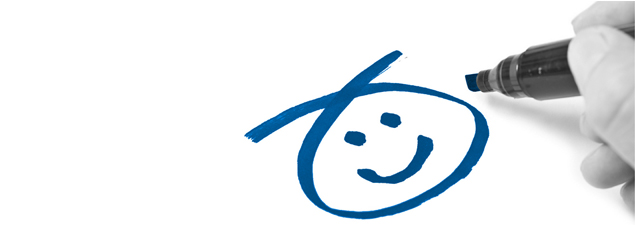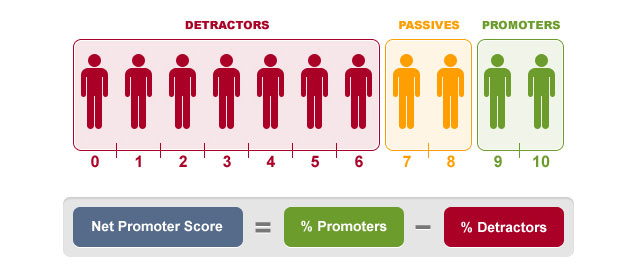Is Hively The Same As The Net Promoter System (NPS)?
Posted on June 7th, 2012

We often get asked if using Hively is similar to measuring customer happiness with the Net Promoter Score (NPS). Our answer is – yes… and no.
Much of the fundamental components of Hively are based on NPS. However, Hively improves upon the NPS rating system in several ways. Below we’ve listed all the ways we see Hively being the same and different from the Net Promoter Score.
1) Being specific. The NPS method asks one question “Would you recommend our company?” While the question is great, from our perspective, it’s more important to get feedback on the specific individuals working with your customers, as opposed to getting general feedback on your company as a whole. People don’t interact with ‘companies,’ they interact with people. Getting detailed and specific feedback on these individuals gives you a more accurate measure of your overall customer happiness and how your company is performing as a whole.
For example, how does the NPS score really help Apple? Apple makes amazing products that people love. So, when asked as a whole “Would you recommend our company?” most people would respond yes. However, if you asked a customer what they thought about the service rep that helped them buy the laptop, they might give you a very different and specific answer that is much more useful, predictive and actionable.
In this case – Hively differs greatly from NPS. Hively gives you specific feedback on each individual team member your customers interact with. Through this feedback you are able to more accurately assess the overall customer happiness for your entire team.
2) Rating scale. The most common NPS method of measurement is the 11 point scale (0 – 10) where 0 through 6 are detractors, 7 through 8 are passive, and 9 through 10 are promoters. There are several issues with this kind of scale.
The scale needs labels. Labeling scales is imperative. Respondents must have a labeled scale and understand it in the same way. Otherwise, the scale will produce results from a subjective response bias.
The NPS rating scale tends to be biased and subjective. Statistically speaking, the 0 – 10 NPS scale is extremely biased toward detractors. Among the 3 categories, detractors have the widest range and highest probability (0 – 6), while passives and promoters each have only a range of 2 (7-8 and 9-10 respectively). While providing answer choices to a question or survey it’s best to have an equal range for each response type. This ensures the answers have equal weight and the respondents have an equal chance of picking each point of view.
Many NPS proponents might argue that the bias is by design, but this presents even more issues. Different societies and cultures have different ways of evaluating quantitative metrics and giving feedback. Some are much more “stingy” with their scoring, being much less likely to give higher ratings. Because of this difference and subjectivity, someone who gives a score of 8 might feel they’ve given you an amazing score. However, the NPS method will categorize them as passives.
No set scale. Although the 0 – 10 scale is the most common scale of measurement, NPS doesn’t endorse any single scale. For example, some companies implement NPS with a 5 star rating system. Further, some companies will actually use different scales to ask different questions all within the same company. This inconsistency makes the results difficult to truly measure and impossible to compare overall NPS scores with other companies.
To this point, Hively also differs from NPS. Hively provides a simple, single rating scale that is labeled and universally understood – Happy face, Satisfied face, Unhappy face. That said, the resulting Hively score is actually somewhat similar to NPS. With Hively, team members get +1 point for a Happy rating (Promoter), 0 for a Satisfied (Passive) and -1 for an Unhappy rating (Detractor).
3) Taking action. What if you have a good NPS score? What does that mean? Say, for example, in one industry, ACME, Inc. has the best NPS score. What does that really mean? Is it the best because of the technology, the service, the products? AMCE, Inc. is the company; but what product, service or team member is actually worth recommending, if any at all? There’s no real way of knowing.
The opposite is also true. What if you had a bad NPS score? What do you do? Is it a particular under performing or unprofitable product or service that should be discontinued? Is it because you need to clean house on your customer support team? Without specifics, you have no way of knowing.
Hively differs from NPS here as well. Because team members and team leaders and alerted whenever feedback is given, Hively lets you take immediate action on customer feedback. If positive ratings come in, use them to encourage and reward your team members. If negative feedback is received, discuss the issue and identify a solution with your team members. Then, immediately follow up with your customer and resolve their issue. Watch your unhappy customer become HAPPY!
4) Real time feedback. Most companies implement the NPS method in the form of surveys that get sent annually, twice per year or quarterly at best. During the times in between you’re potentially loosing customers! Checking in this infrequently with customers is simply not enough and is a good way to let small issues turn into larger ones that lead to a high level of customer attrition.
This is one of the most prominent areas where Hively differs from NPS. One of the key values of Hively is that it provides you with real time feedback. You and your team members a notified within seconds of getting feedback from a customer.
 5) Properly implementing NPS as a method of measuring customer feedback is costly and time consuming. NPS can be such a large task that most companies work with outside consultants to implement and run everything for them. Although working with such consultants can be quite valuable and will ensure your NPS program is implemented successfully, it will also be quite time consuming an very expensive. Many companies simply can’t afford the time or cost of this effort.
5) Properly implementing NPS as a method of measuring customer feedback is costly and time consuming. NPS can be such a large task that most companies work with outside consultants to implement and run everything for them. Although working with such consultants can be quite valuable and will ensure your NPS program is implemented successfully, it will also be quite time consuming an very expensive. Many companies simply can’t afford the time or cost of this effort.
Hively again differs from the NPS method here. Hively is the simplest way to gather customer feedback. We’ve seen teams of nearly 100 people or more get set up with Hively in less than 10 minutes. Best of all – that same teams pays only $99/month for real time feedback and the ability to reward their top performing team members. Compared to what you would pay a consulting firm to implement NPS for you, this price is a rounding error. 🙂
Hopefully this helps highlight the differences and similarities with Hively and the Net Promoter Score. To be clear, we think the NPS method of measuring customer feedback has many great qualities, but also much room for improvement. Further, unlike their first book, “The Ultimate Question,” the authors of “The Ultimate Question 2.0” have taken the focus off the NPS score and the 11 point rating scale and placed more emphasis on the core concept and closed loop feedback process. They’ve even renamed NPS from Net Promoter Score to Net Promoter System. We personally think these changes are great and make Hively even more similar to the NPS method than before.
Be the first to comment!

